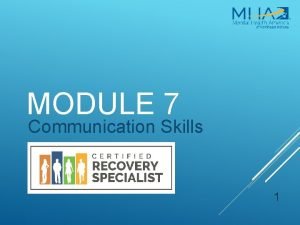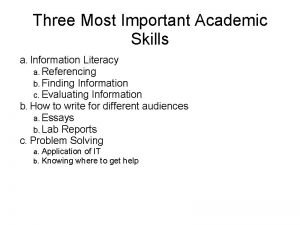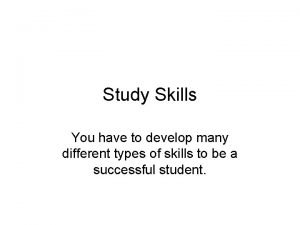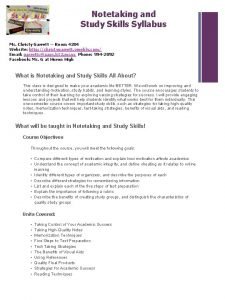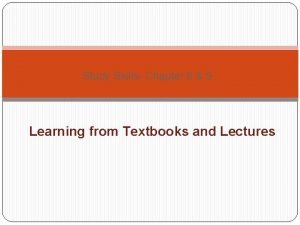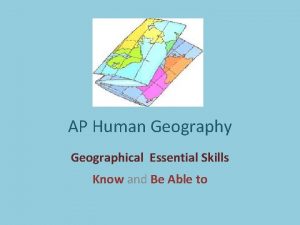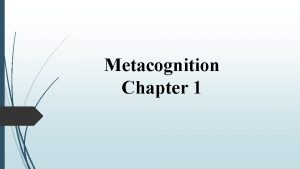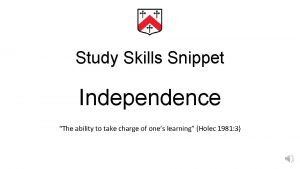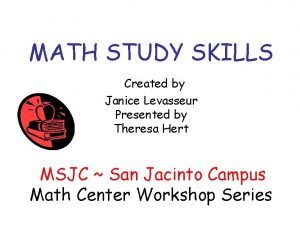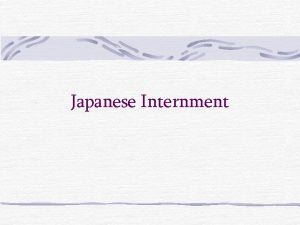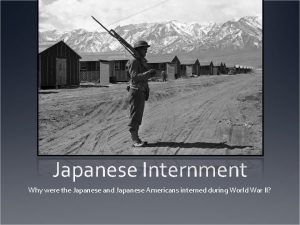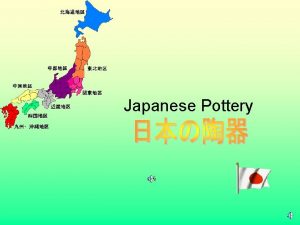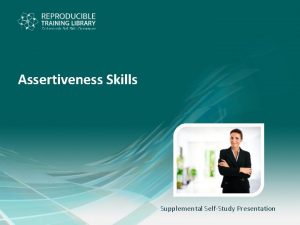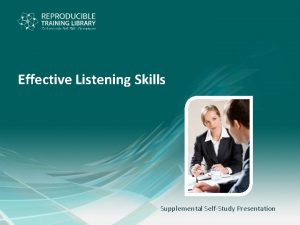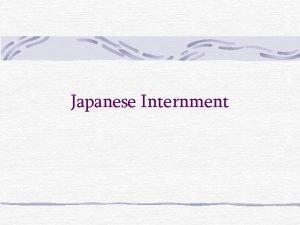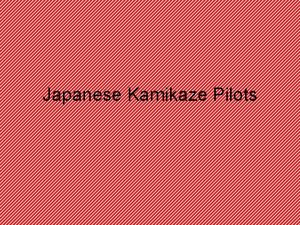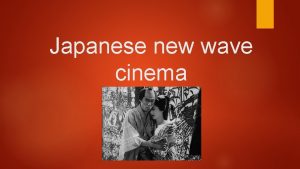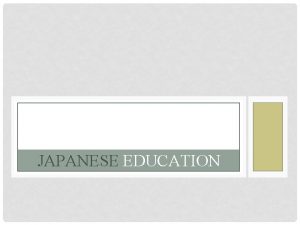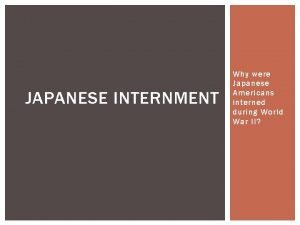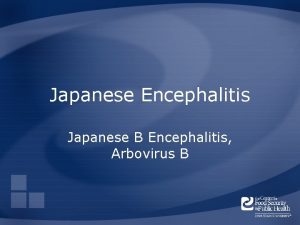JAPANESE STUDY SKILLS A FOCUS ON SELFSTUDY MY


























- Slides: 26

JAPANESE STUDY SKILLS A FOCUS ON SELF-STUDY

MY SITUATION THEN NOW • An idiot • A genius • Never formally studied Japanese • Now at N 2 level, took N 1 in December. • Started when I found out I was on JET. • Can read native-level stuff, albeit looking up • Did the basics before coming here – katakana and hiragana some words and not always particularly fast • Reading and kanji skills are strong; speaking and listening are weakest. • Knew very basic kanji, grammar and • Still have problems with speaking due to not practicing enough vocab, possibly enough to pass JLPT N 5 • Listening has developed organically due to • Came to Japan, realized I couldn’t understand a word anyone was saying. living here, but I’m not strict enough with listening study.

WHAT’S YOUR FOCUS? Your approach to studying and your study methods will largely be determined by what you want from Japanese. • Do you want to be able to talk to other teachers? • Do you want to pass the JLPT? • Do you want to work for a Japanese company? • Do you want to read your favorite manga/watch your favorite anime/play your favorite game in Japanese? Even if you don’t have a particular reason for studying, it’s good to find something to focus on. Simply wanting to be “fluent” isn’t a great end goal, as it’s vague and ill-defined.

THE JLPT • A standardized International test. Apply at http: //info. jees-jlpt. jp/# • Held twice a year in July and December. • In Gifu, it’s usually held at one of the two Universities – Gifu Daigaku or Tokai Gakuin. • Goes from N 5 (beginner) to N 1 (advanced). • Most non-teaching jobs require N 1 or at the least N 2. • Other levels aren’t useless though – still a qualification to stick on your CV. • Test consists of Kanji/ Vocab/Grammar, Reading and Listening sections. No speaking section. • Multiple choice questions, quite old-fashioned and relying on rote-memorization. • Scoring is quite lenient, only needing around 90/180 to pass. However there is a minimum score of 19/60 needed for each section.

MY APPROACH • A textbook learner. • 90% of my studying has been at my desk during free periods. • Focus has been on passing the JLPT and progressing through the levels each year. • The JLPT gives me a focus and an end goal to work towards. • When starting a new level for the first time, I tend to work in the order of: Kanji > Vocab > Grammar > Reading > Listening. • Ditch romaji as soon as possible. It’s a crutch and it can mess with your pronunciation too. • Don’t be scared of kanji. A lot of textbooks start out with just hiragana/katakana and stay with them for too long. Learn kanji from day one. Some of the simplest kanji are used the most frequently. • I don’t learn all the different readings of a kanji, I learn them through learning words. From the start, whenever I learned a new word, I would learn the kanji for it too.

PROS OF SELF-STUDY • Independence • Freedom – you pick what you study and when to study. • Can be cheaper than expensive classes – unless you buy loads of textbooks, though you can sell these on. • You can progress a lot faster than in classes, if you’re dedicated enough. • You can make it as immersive as possible and blur the line between studying and recreation. • You’re able to focus on non-academic media, such as books, You. Tube, TV etc.

CONS OF SELF-STUDY • Needs discipline and motivation. • Your skills don’t always develop equally. • A danger of “studying for the test”, especially if you’re doing the JLPT. • Sticking with familiar study methods and getting in a rut. • No feedback or evaluation. Difficult to realize when mistakes are being made, or how to correct them. • Needs self-awareness and self-correction, especially in regards to weakpoints. • Weakpoints need to actively be addressed. I don’t study listening as it’s the part I like the least, therefore I study it the least. Classes would give you much more balance. • The danger of procrastination – it’s all too easy to be sitting at your desk intending to study, but then fall into a reddit blackhole of which it is impossible to emerge. • Make your learning ACTIVE not PASSIVE – this is especially important when you’re doing more casual self-study, like watching You. Tube, or an anime, or talking to a friend in Japanese.

ANKI/SRS/FLASHCARDS • Often a key component of any self-study routine. Plenty of ready-made decks out there, or you can make your own (though takes quite a lot of time inputting them). • Many recommend the Anki 2 K/6 K/10 K premade vocab decks. There also ones tailored to the JLPT. • Not just limited to vocab drills, you can include grammar, full sentences, ones with audio etc. • Needs self-discipline to do regularly every day. Easy to do at your desk, on your phone, on the train, etc. • Shouldn’t be the main focus of your studies though – a daily supplement to other things. • Be careful not to get a backlog – you don’t want to do 200 cards just to get back on track. • If you’re making cards yourself, you need to consider what makes a “good” and “bad” flashcard:

KANJI AND MNEMONICS • Don’t be scared of kanji, don’t put off learning them. • The Japanese way of learning kanji – by rote memory, writing them down hundreds of times – is inefficient. • You’re probably not going to need to write things by that often. Learn how to write until you get basic stroke order down. • There are quite a few kanji mnemonic tools out there – the book “Remembering the Kanji” is popular with beginners, as is the Wani Kani SRS tool https: //www. wanikani. com/ Wani Kani isn’t free, but you can dabble with the first few levels as a trial. • Mnemonics rely on a imagined story to create a visual link between this and a kanji. For example, 休 contains the “man” radical and the “tree” radical, it’s a man relaxing against a tree in the sun, conjuring up the image of “rest”. • RTK doesn’t tell you the kanji readings. Wani Kani includes a reading mnemonic too.

KANJI AND MNEMONICS • An example from Wani Kani for 外: CONT.

KANJI AND MNEMONICS CONT. • If you start a mnemonics course, you often have to stick with it in order for it to pay off long-term. • Mnemonics need repeated reinforcement. • My approach is generally to learn a new word, in kanji, then go learn other words using that same kanji. Often this reinforces meaning. For example, 外国、海外、外交、以外、 郊外 all contain some notion of “outside”. • I find mnemonics to be a lot of grunt work just for one word/kanji. Uses a lot of English too. • Some kanjis like 生 have many readings. Often a mnemonic covers one of them, for example 生as “せい”, so you might have some trouble remembering 生きる or 誕生日. • However, if you’re struggling with a particular kanji or a reading, a mnemonic can help. • I prefer seeing the kanji in more “natural” ways, or in full sentences, and getting used to its meaning through content.

COMPREHENSIBLE INPUT • You’ll be deciding what sort of content you study. It’s important to not get stuck in a comfort zone, but also not to over-reach. • You should aim for things that are your current level “+1”. Just beyond your level of understanding, but not completely unintelligible. • This will help you to learn things more naturally, at a regular pace. • Attempt to learn something that is “+5” or way ahead of your current level, is often not an efficient use of your time. Brute forcing your way into more advanced content is counter-productive. • For SRS drills, there should only be one “unknown” on each card/in each sentence. You need to focus on that “+1” rather than trying to remember multiple things at once.

SHADOWING/SPEAKING • As a self-studier, it can be hard to get adequate speaking practice. • A lot of it is memorizing sample sentences and repeating them, so you won’t create any output yourself. • However I did find that some key phrases or responses stuck in my head, and I found myself hearing them said elsewhere and noticing them more. • Though nothing replaces another human being for speaking practice – just if it is studying, make sure you get correction and feedback. Don’t let them ignore your mistakes.

GENERIC MOTIVATIONAL ADVICE • Don’t get disheartened. • There’s no one-size-fits-all study method. There’s no “get rich quick” scheme either. • Language learning isn’t a constant upward curve – it has peaks and troughs. • The “Intermediate Plateau” is a thing. A point where you know enough to get by, but progressing to the higher level, native stuff feels like a big step up. • Your skills won’t develop equally either. • Don’t compare yourself to others. Everyone gets language-envy and there’s always going to be someone better at Japanese than you. • You’ll probably learn more from one mistake than one right answer.

TEXTBOOK RESOURCES – JAPANESE FROM ZERO SERIES PROS • • Very easy to use. For absolute beginners. Informal and relaxed style. Has an accompanying website https: //www. yesjapan. com/ and loads of videos about learning Japanese. CONS • Pace is very slow. • Aimed at younger learners. • Website locks a lot of content behind a paywall.

TEXTBOOK RESOURCES – GENKI I AND II PROS • Has an accompanying workbook for practice. • Fairly comprehensive for a beginnerlevel textbook. Should take your right to the gates of Mordor Intermediate level Japanese. • Clear and concise, easy to use. CONS • Meant to be used alongside a teacher or classes. • A little expensive compared to others.

TEXTBOOK RESOURCES – DICTIONARY OF BASIC/INTERMEDIATE/ADVANCED GRAMMAR PROS • In-depth and exhaustive (if you own all three) • Useful for learning how to differentiate between other, similar, grammatical forms. • Many example sentences, with English translations and explanations throughout. CONS • A little expensive compared to other textbooks – around 4000 yen. • For serious learners, owning all three is a good idea (Advanced is perhaps only needed for those studying the JLPT or more serious stuff) • Not textbooks per se, but more of a reference – you’ll need other grammar resources for studying alongside this.

TEXTBOOK RESOURCES – SOU MATOME SERIES PROS • • • Easy to use Simple layout English translations Good as an intro Organized into 8 week chunks, so easy to keep to a schedule CONS • A little too simplistic, especially for advanced learners • Needs to be backed up with other resources. Often need to look stuff up elsewhere to get a firmer grasp on things. *N. B. N 3 -N 1 has individual textbooks for grammar, listening, kanji etc. whereas N 4 and 5 is just one collective volume

TEXTBOOK RESOURCES – KANZEN MASTER SERIES PROS • All in Japanese, so no using English as a crutch. Helps with general reading speed and kanji ability too. • Japanese grammar explanations in Japanese, to aid understanding • Tells you when to use – and when not to use – grammar points, rather than just translating or explaining the English meaning. CONS • All Japanese, so a higher barrier to entry than Sou Matome. • Reading ability needs to be a bit higher than other textbooks. • Not as beginner-friendly in terms of layout and graphics compared to others. Pretty dry and “textbooky”. • *N. B. Only available for N 4 and onwards. N 4 seems to have some English.

INTERNET RESOURCES • Jisho. org https: //jisho. org/ My go-to online dictionary. Easy to use and clearly presented. Has a variety of different functions, for example, searching for all words containing a certain kanji, searching by JLPT level, drawing an unknown kanji etc. • Goo https: //dictionary. goo. ne. jp/ Just starting using this. It’s not as clear as Jisho but is arguably better for advanced learners due to providing Japanese-Japanese definitions. You want to use as little English as possible as you get better/quicker at reading and using Japanese. • Reddit https: //www. reddit. com/r/Learn. Japanese/ (and other related subreddits) Useful to browse for five mins each day. Usefulness often depends on what other users post, but you can also ask questions of your own and get an answer. There’s also a Starter’s Guide with some helpful advice. • Japanese Stack Exchange https: //japanese. stackexchange. com/ Similar to reddit, though a bit more study-orientated. Any time you have a question you should ask it here.

INTERNET RESOURCES CONT. • Anki/SRS As previously mentioned, it’s also a phone app, a desktop app and a website. • i. Talki https: //www. italki. com/home This is cheating a little as it’s not really self-study, but online lessons with a teacher. • NHK Easy https: //www 3. nhk. or. jp/news/easy/ Useful for advanced beginners up to intermediate (JLPT N 4 and N 3). These are news articles, but skewed towards simpler Japanese. You get furigana above the kanji, you get names of people, companies or places highlighted to make them easier to discern and you get definitions of tricky words. You can also listen to the article being read, as well as being able to turn off the furigana to make it more of a challenge. My approach when I started reading articles was to focus on international news I was already aware of in English. This helped with reading speed and figuring out what new words could mean. • NHK https: //www 3. nhk. or. jp/news/ The “proper” version of the news. When it’s time for big school. Often accompanied by a video of the news in question with a voice over, so you can study the article and then practice listening. I find the articles here easier to read than a newspaper, with the added benefit of being able to easily look stuff up online.

INTERNET RESOURCES CONT. • Tae Kim’s Guide http: //www. guidetojapanese. org/learn/grammar Imabi https: //www. imabi. net/ Decent grammar guide for beginners. Available on the website, in PDF form and also now in an app. Has a lot of English, but useful for people starting out and teaches you the basics you’ll need to progress. Imabi seems to be similar and goes to a more advanced level, haven’t used it personally. • Tofugu https: //www. tofugu. com/ The Don Quixote of Japanese study sites. Has a lot of info strewn all over the place, as well as a Kanji SRS tool (Wani Kani) and a online textbook of it’s own. Has a lot of information about Japanese culture too. I find it uses too much English and is quite wordy, but it’s a pleasant site to use. Be careful, if you’re studying, to be actually studying – not just reading about study Japanese. • Satori Reader https: //www. satorireader. com/ Online articles with a variety of settings and functions, mainly for intermediate learners. Could be useful for those wanting to read non-fiction, but who are not quite ready for the daunting task of a novel. Can be synced with Wani Kani too. Has various tools to make reading easier, such as furigana, looking up a full translation etc. Possibly more interesting content than just news articles. More suited to intermediate learners than advanced.

YOUTUBE There a ton of channels out there for learning Japanese. • Nihongo no Mori Has videos covering all the various JLPT stuff. • Dogen https: //www. youtube. com/user/Dogen His pitch accent series is good for learning correct pronunciation, though you will need to subscribe to his Patreon for all those videos. He also does loads of little comedy skits in Japanese too. Generally held up as having a pretty bang-on accept for a puny gaijin. • Japanese from Zero The channel accompanying the textbooks. I watched these back home before coming to Japan and they are fairly entertaining and lightweight. Not great for intensive or advanced studying, but good for beginners. A word of warning about You. Tube – make sure you’re actively studying, not just passively watching. There are quite a few interesting channels about Japan/Japanese learning that can contain a few about of English. Don’t let these replace actual listening practice.

PHONE RESOURCES • Duolingo https: //www. duolingo. com/course/ja/en/Learn-Japanese-Online Never actually used this for Japanese – there wasn’t a course when I first started – but have used it to learn other languages. Very user-friendly. Not sure if it would be suitable for intermediate learners and beyond though. • Memrise https: //www. memrise. com/ Similar to Duolingo but this has user-created courses and has a much wider range. There are decks for all JLPT levels, as well as core vocab and grammar etc. As courses are user-created, you’re at the mercy of the content creator so quality can be a little variable. You aren’t able to tailor the flashcards to your own style like with Anki. • Hello Talk app Designed to help people find others learning their language, and to find native speakers of your target language. Useful for writing messages and getting some correction, which can be quite hard in everyday conversations. You can write blog-style posts, message people to chat and even have a phone conversation if you wish. A word of warning though – some people do use it as a dating app.

SCHOOL RESOURCES • Real life human beings • School libraries • Worksheets from English class • Those kanji drill books the ES kids have (漢字ドリル) I was given a load of this by the secretary at my ES when she saw me studying. You might have seen your students using them, but they have them throughout ES so you get quite a wide range of kanji. You’ll learn them like the kids do – rote memorization – but you do get to practice writing them, introduced to other words that use the same kanji and you get to see them in sample sentences. • Sitting in on other classes If you have a good relationship with other teachers and a high enough listening level, you can ask to stand at the back of other classes. I’ve done it in Social Studies classes and you see a lot of JLPT N 2 and N 1 vocab at JHS. ES Japanese classes are good too, and I’ve even joined in in a 2 nd grade calligraphy class. Was good for my self-esteem knowing more kanji than a six year old. • School circulars and notices You know those weekly notices you get on your desk which contains loads of indecipherable nonsense? Well they can be quite useful for learning work or school-related words. I used to give them a cursory glance and see if any words were repeated frequently or, once my level got a little higher, would try and read the odd paragraph. Also useful for figuring out what is going on at work and can be a topic of conversation. Though it’s often just indecipherable nonsense.

REAL LIFE RESOURCES • Netflix If you use Japanese Netflix, there’s a wealth of stuff on there. It has English subtitles for beginners, and Japanese ones for intermediates. Its one big advantage over live TV is the ability to pause and rewind, which make it a much better learning tool. • TV Not as useful as Netflix but still handy. Especially if you like shows about food and the reactions of Japanese C-list celebrities. • Anime Not something I personally use, but it’s something that a lot of people have an interest in. There a lot of them on Japanese Netflix and you’ll get subtitles and that precious, precious rewind/pause function. Again, make sure you’re studying instead of just watching – keep a notebook handy for unknown words, practice shadowing etc. • Videogames Book Off and similar stores have cheap second hand games. Just be it’s actually studying and not playing. Some games for kids might be all-hiragana too, so make sure to pick one that matches your level. • Books/Manga Again, plenty of places sell these second hand. With books, be careful not to overreach and go for something too difficult or time-intensive. Certain manga are probably guilty of having a lot of made-up
 Prolepsis
Prolepsis Porter competitive strategy
Porter competitive strategy Cost focus and differentiation focus
Cost focus and differentiation focus Actor focus vs object focus
Actor focus vs object focus This module will focus on communication skills at work
This module will focus on communication skills at work Chinese second language study design
Chinese second language study design Intrapersonal skill adalah
Intrapersonal skill adalah Hard and soft skills
Hard and soft skills Ontario skills passport essential skills
Ontario skills passport essential skills What are study skills and why are they important
What are study skills and why are they important What are study skills and why are they important
What are study skills and why are they important Developing effective study skills
Developing effective study skills Study skills syllabus
Study skills syllabus Study skills answer key chapter 4
Study skills answer key chapter 4 Apt-s study skills framework
Apt-s study skills framework Essential skills to study geography
Essential skills to study geography Questionnaire on study habits of students
Questionnaire on study habits of students The importance of study skills
The importance of study skills Study skills
Study skills Study skills
Study skills Study skills answer key chapter 4
Study skills answer key chapter 4 Study skills curtin
Study skills curtin Junior study skills
Junior study skills Ecological study vs cohort study
Ecological study vs cohort study Retrospective cohort study vs prospective cohort study
Retrospective cohort study vs prospective cohort study What is work study in management
What is work study in management Marty lobdel
Marty lobdel




